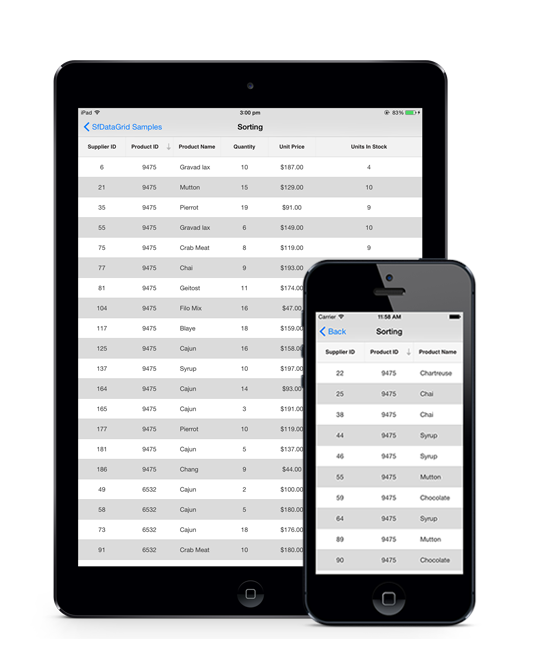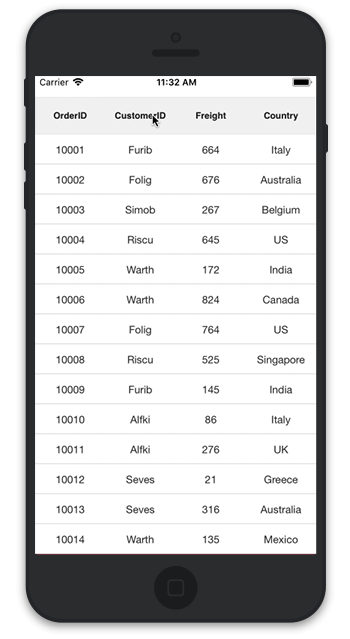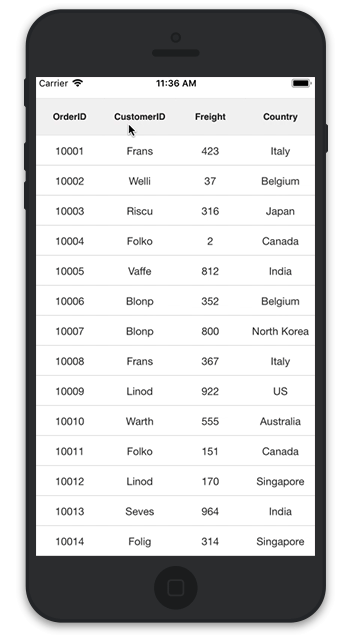Sorting
1 Mar 202210 minutes to read
The SfDataGrid allows applying sorting on its data by setting the SfDataGrid.AllowSorting property to true. It allows sorting the data adjacent to one or more columns. When sorting is applied, the SfDataGrid automatically rearranges the data to match the current sort criteria. When SfDataGrid.AllowSorting is true, you can sort the data simply by tapping the column header you wish to sort. Once sorting is applied, the SfDataGrid shows a sort icon in the respective column header indicating the direction of sorting.
NOTE
To update sorting for a newly added row or column, set the
SfDataGrid.View.LiveDataUpdateModetoLiveDataUpdateMode.AllowDataShaping.
Programmatic sorting
The SfDataGrid also allows performing sorting from the code. This requires you to manually define the SortColumnDescription objects and add it in the SfDataGrid.SortColumnDescriptions collection. The SfDataGrid sorts the data based on the SortColumnDescription objects added to this collection.
The SortColumnDescription object holds following two properties:
- ColumnName: Name of the sorted column.
- SortDirection: An object of type ListSortDirection that defines the sorting direction.
The following code example illustrates this.
dataGrid.AllowSorting = true;
dataGrid.SortColumnDescriptions.Add (new SortColumnDescription () {
ColumnName = "OrderID",
SortDirection = ListSortDirection.Descending
});The following screenshot shows the sorting functionality in the SfDataGrid.

Tri-state sorting
In addition to sort the data in ascending or descending order, the SfDataGrid also allows you to unsort the data to the original order by clicking the header again after sorting to descending order by setting the SfDataGrid.AllowTriStateSorting property to true. When this property is set, sorting in each column iterates through three sort states; ascending, descending, and unsorted.
The following code example shows how to enable tri-state sorting in the SfDataGrid.
dataGrid.AllowTriStateSorting = true;
Multi-column sorting
The SfDataGrid allows sorting the data against more than one column by setting the SfDataGrid.AllowMultiSorting property to true. The number of columns by which the data can be sorted is unlimited. To apply sorting for multiple columns, tap the desired column headers after setting the SfDataGrid.AllowMultiSorting property.
The following code example shows how to enable multi-sorting in the SfDataGrid.
dataGrid.AllowMultiSorting = true;
Sort column in double-click
By default, the column gets sorted when the column header is clicked. You can change this behavior to sort the column by double-clicking by setting the SfDataGrid.SortTapAction property as DoubleTap.
The following code example shows how to set SortTapAction is DoubleTap in the SfDataGrid.
dataGrid.SortTapAction=SortTapAction.DoubleTap;Sorting Events
The SfDataGrid provides the following events for the sorting functionality:
- SortColumnsChanging: Raised while sorting the column at execution time before the column gets sorted. It helps to cancel the sorting action by setting the Cancel property of DataGridSortColumnsChangingEventArgs.
- SortColumnsChanged: Raised after the column is sorted.
These two events are triggered with DataGridSortColumnsChangingEventArgs and DataGridSortColumnsChangedEventArgs that contains the following properties.
-
AddedItems: Gets the collection of
SortColumnDescriptionobjects added toSfDataGrid.SortColumnDescriptionscollection for sorting. -
RemovedItems: Gets the collection of
SortColumnDescriptionobjects removed fromSfDataGrid.SortColumnDescriptionscollection.
The following code example illustrates how to hook the SortColumnsChanging event and cancel the sorting of a column.
dataGrid.SortColumnsChanging += DataGrid_SortColumnsChanging;void DataGrid_SortColumnsChanging (object sender, DataGridSortColumnsChangingEventArgs e)
{
if(e.AddedItems[0].ColumnName == "OrderID")
{
e.Cancel = true;
}
}Custom sorting
The SfDataGrid allows sorting columns based on custom logic when the standard sorting techniques do not meet the requirements. For each column, you can apply different sorting criteria by adding SortComparer objects to SfDataGrid.SortComparers collection.
A SortComparer object has the following properties:
- PropertyName: Defines the MappingName of the column that applies custom sorting.
- Comparer: Gets or sets the custom comparer that implements the
IComparerand `ISortDirection interfaces.
The following code example illustrates how to perform custom sorting for FirstName column based on the string length of the names.
dataGrid.SortComparers.Add (new SortComparer () {
PropertyName = "FirstName",
Comparer = new CustomComparer()
});
dataGrid.SortColumnDescriptions.Add (new SortColumnDescription () {
ColumnName = "FirstName",
SortDirection = ListSortDirection.Descending
});The following code example illustrates how to write a Custom Comparer.
public class CustomComparer : IComparer<Object>, ISortDirection
{
public int Compare(object x, object y)
{
int nameX;
int nameY;
//For OrderInfo type data
if (x.GetType () == typeof(OrderInfo)) {
//Calculating the length of FirstName in OrderInfo objects
nameX = ((OrderInfo)x).FirstName.Length;
nameY = ((OrderInfo)y).FirstName.Length;
}
//For Group type data
else if (x.GetType () == typeof(Group)) {
//Calculating the group key length
nameX = ((Group)x).Key.ToString ().Length;
nameY = ((Group)y).Key.ToString ().Length;
} else {
nameX = x.ToString ().Length;
nameY = y.ToString ().Length;
}
// Objects are compared and return the SortDirection
if (nameX.CompareTo (nameY) > 0)
return SortDirection == ListSortDirection.Ascending ? 1 : -1;
else if (nameX.CompareTo (nameY) == -1)
return SortDirection == ListSortDirection.Ascending ? -1 : 1;
else
return 0;
}
//Gets or sets the SortDirection value
public ListSortDirection SortDirection { get; set; }
}Animate sorting icons
The SfDatagrid loads two different icons for denoting the Ascending and Descending sort direction states. However, the SfDataGrid allows rotating the DataGridStyle.GetHeaderSortIndicatorUp icon animatedly for denoting the descending state by overriding the DataGridStyle.GetHeaderSortIndicatorDown method and returning null.
The following code example illustrates how to enable the sorting icons animation by writing a custom style.
//Apply custom style to SfDataGrid from code
dataGrid.GridStyle = new CustomStyle ();
//Custom Style class
public class CustomStyle : DataGridStyle
{
public CustomStyle ()
{
}
public override ImageSource GetHeaderSortIndicatorDown()
{
return null;
}
}How to disable sorting for an individual column
The SfDataGrid allows disabling the sorting for an individual columns by using the GridColumn.AllowSorting property. The default value of this property is true so, all the columns in the SfDataGrid.Columns collection can be sorted when SfDataGrid.AllowSorting is set to true.
To disable sorting for an individual column, follow the code example.
For auto generated column
public MyViewController()
{
dataGrid = new SfDataGrid();
viewModel = new ViewModel();
}
public override void ViewDidLoad()
{
base.ViewDidLoad();
dataGrid.ItemsSource = viewModel.OrdersInfo;
dataGrid.AllowSorting = true;
dataGrid.AutoGeneratingColumn += DataGrid_AutoGeneratingColumn;
this.View.AddSubview(dataGrid);
}
private void DataGrid_AutoGeneratingColumn(object sender, AutoGeneratingColumnEventArgs e)
{
// Sorting will not be done for the Freight column
if (e.Column.MappingName == "Freight")
e.Column.AllowSorting = false;
}
public override void ViewDidLayoutSubviews()
{
dataGrid.Frame = new CGRect(0, 30, this.View.Frame.Width, this.View.Frame.Height);
base.ViewDidLayoutSubviews();
}For manually defined column
public MyViewController()
{
dataGrid = new SfDataGrid();
viewModel = new ViewModel();
}
public override void ViewDidLoad()
{
base.ViewDidLoad();
dataGrid.ItemsSource = viewModel.OrdersInfo;
dataGrid.AutoGenerateColumns = false;
dataGrid.AllowSorting = true;
dataGrid.Columns.Add(new GridTextColumn() { MappingName = "OrderID" });
// Sorting will not be done for the Freight column
dataGrid.Columns.Add(new GridTextColumn() { MappingName = "Freight", AllowSorting = false });
dataGrid.Columns.Add(new GridTextColumn() { MappingName = "Country" });
this.View.AddSubview(dataGrid);
}
public override void ViewDidLayoutSubviews()
{
dataGrid.Frame = new CGRect(0, 30, this.View.Frame.Width, this.View.Frame.Height);
base.ViewDidLayoutSubviews();
}